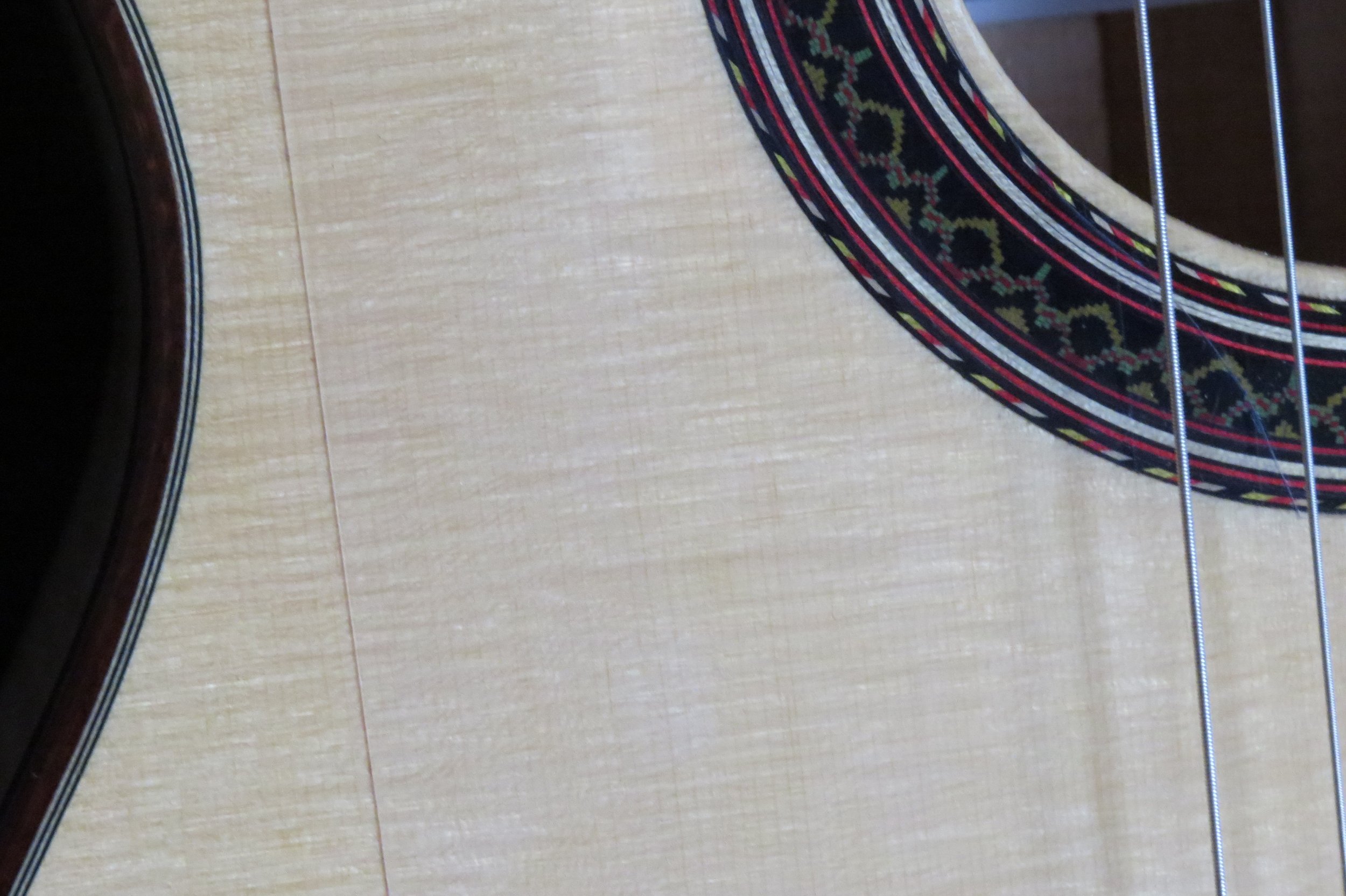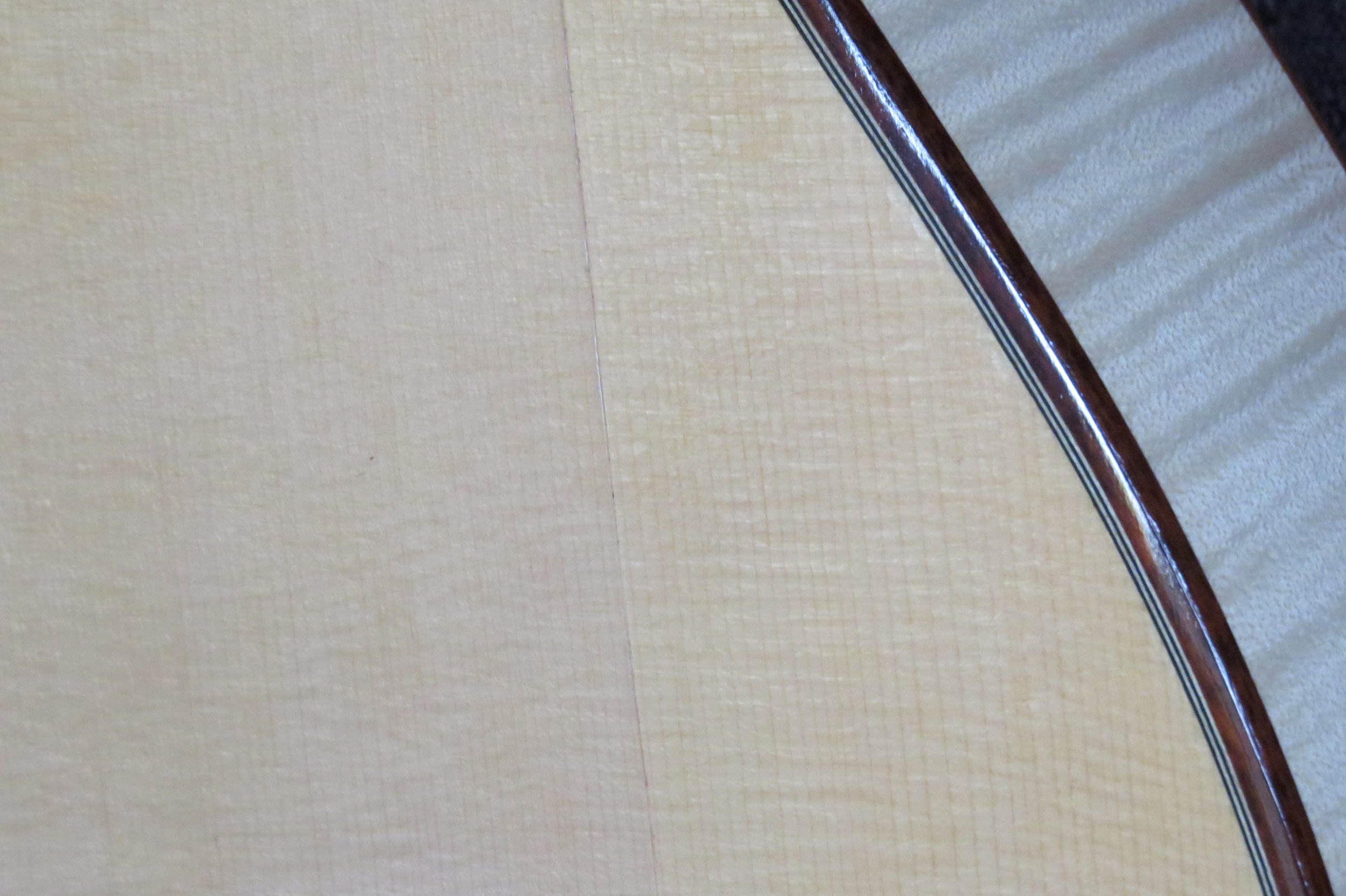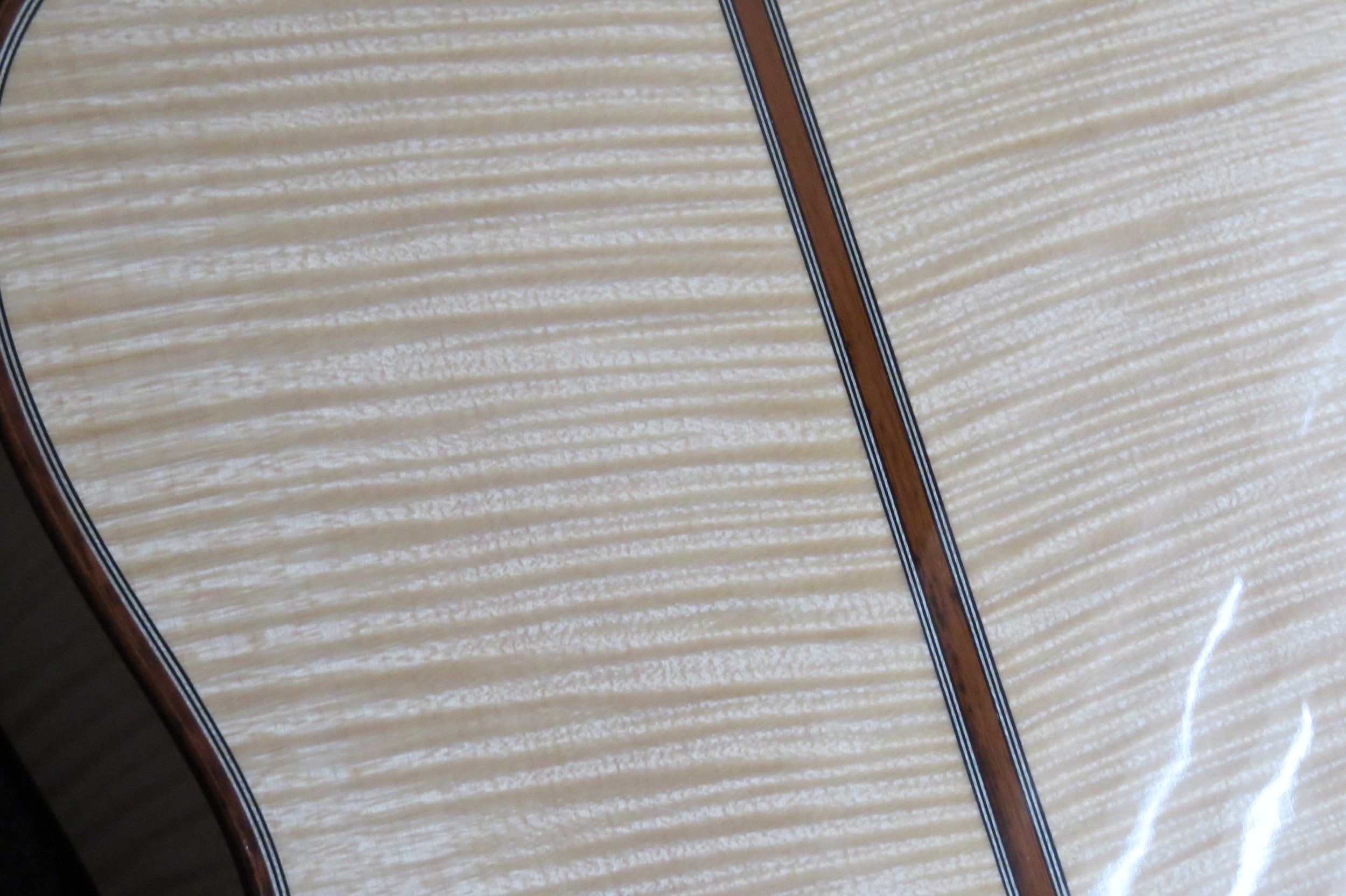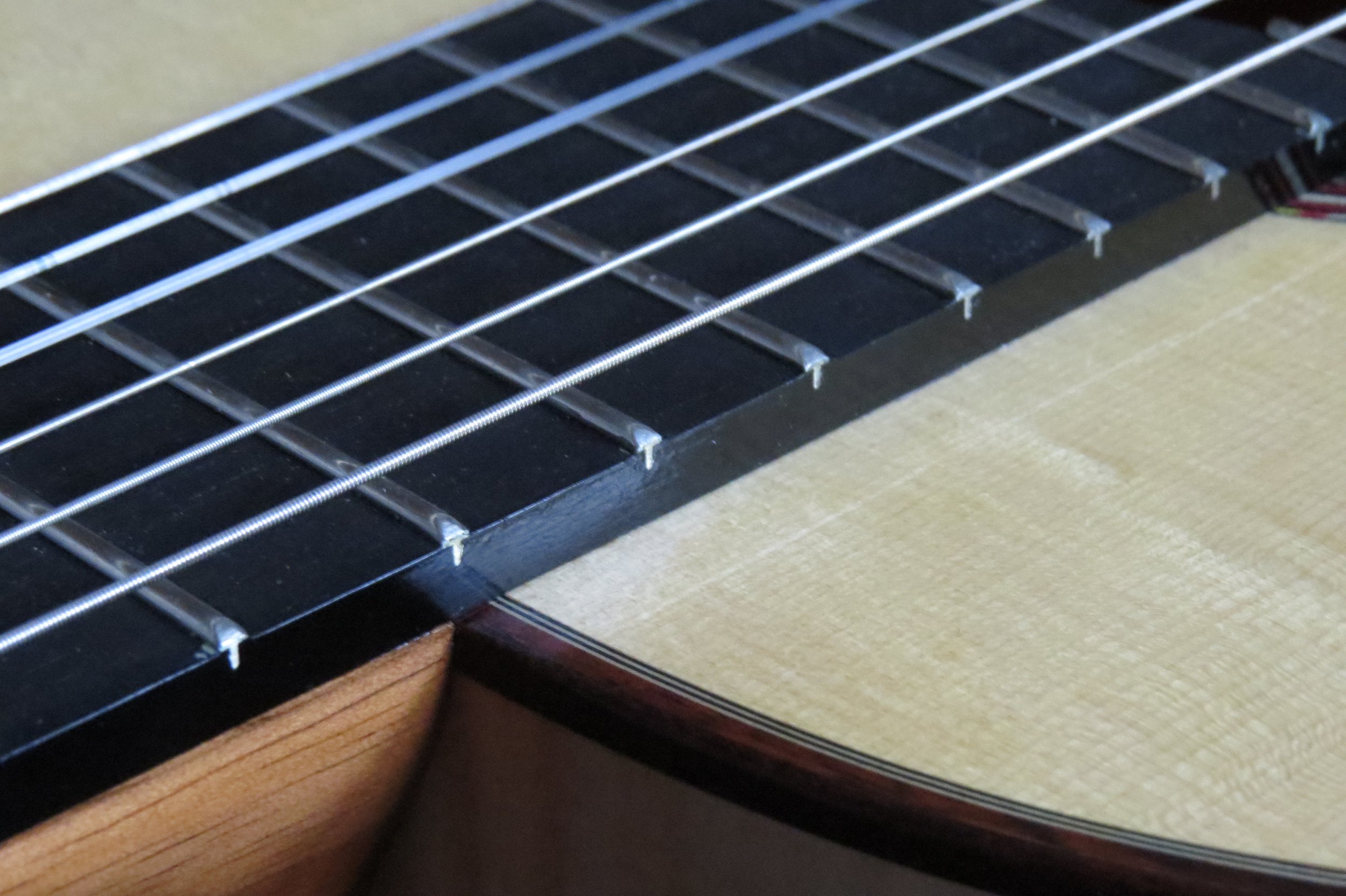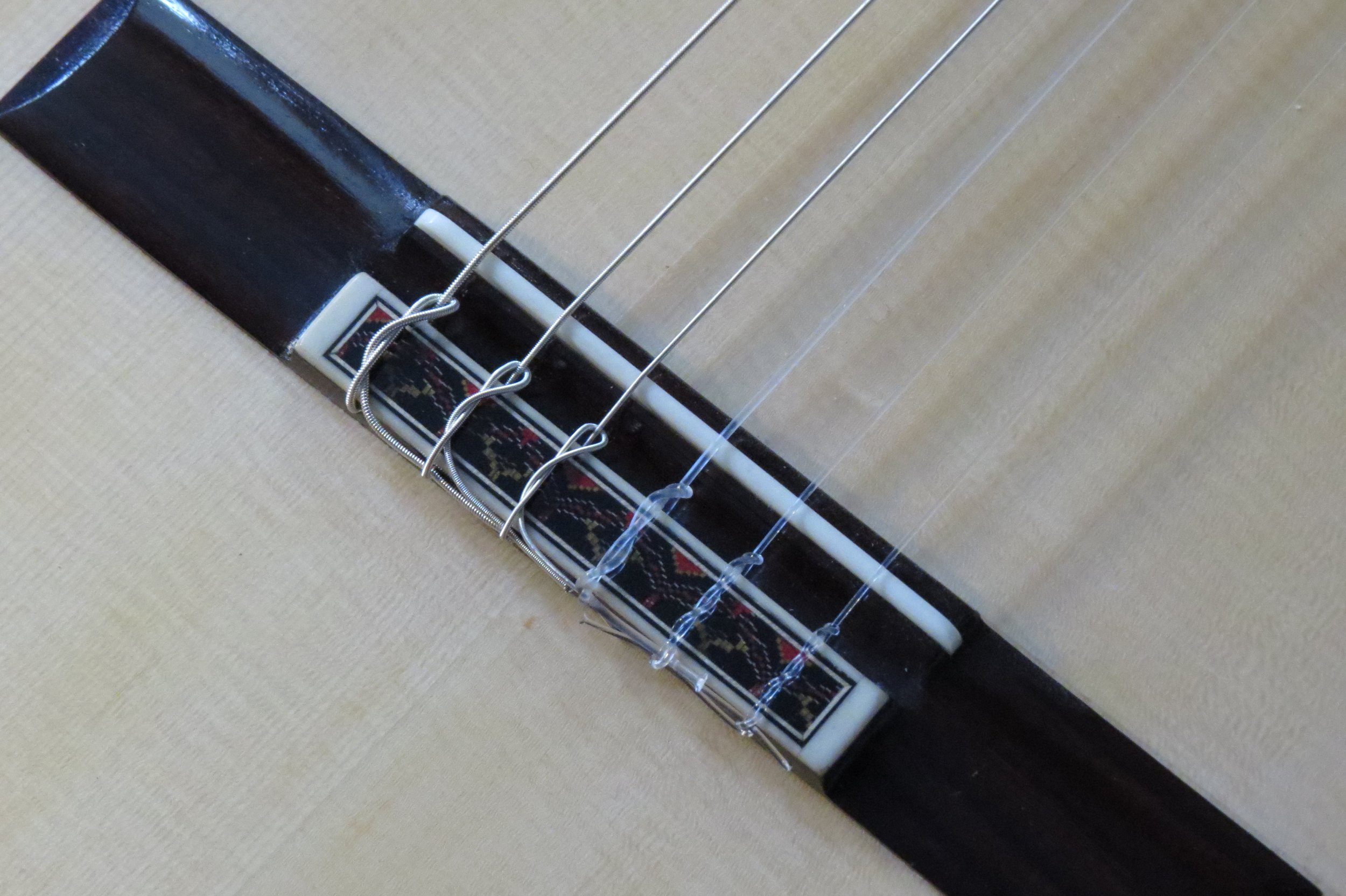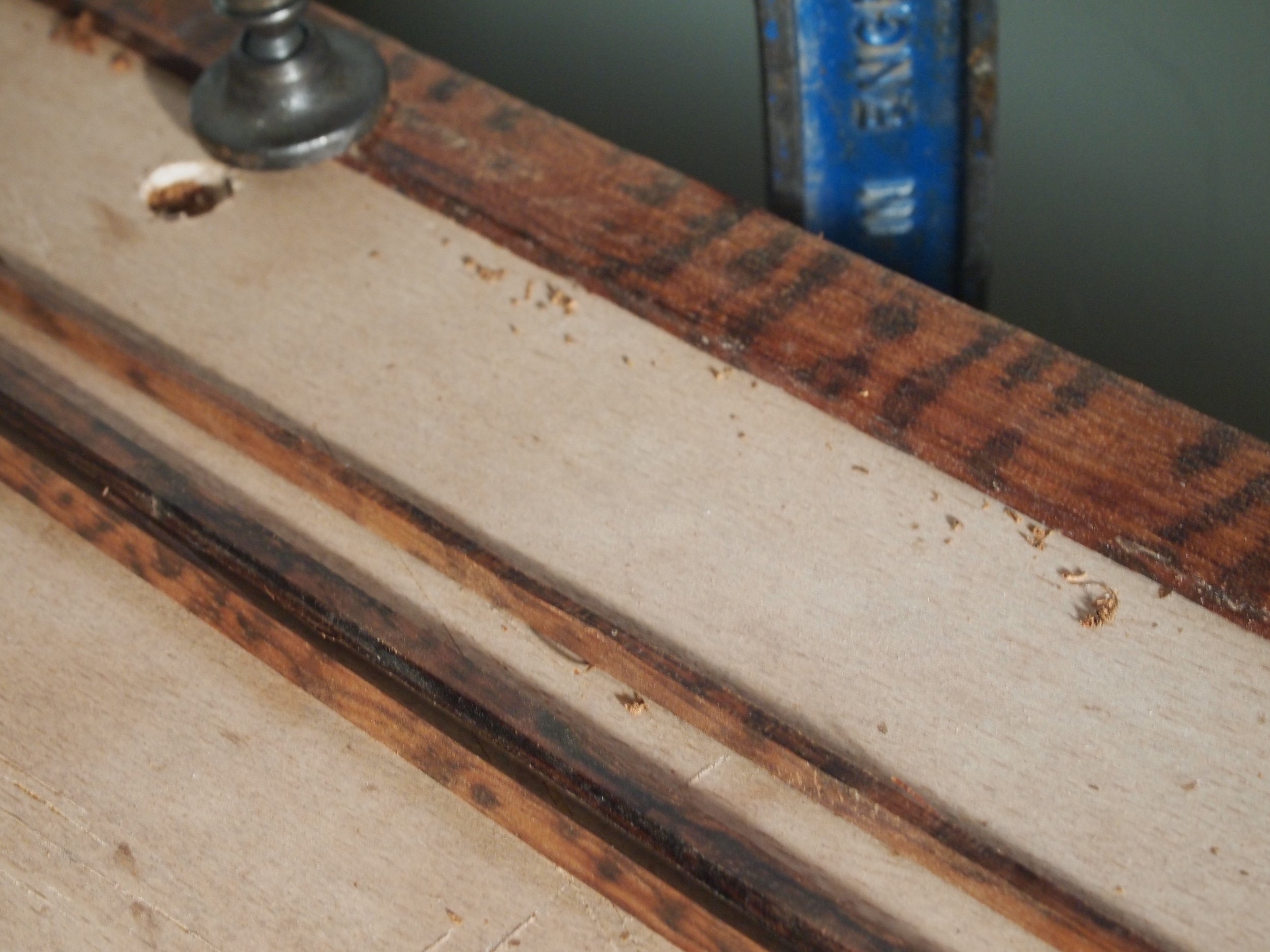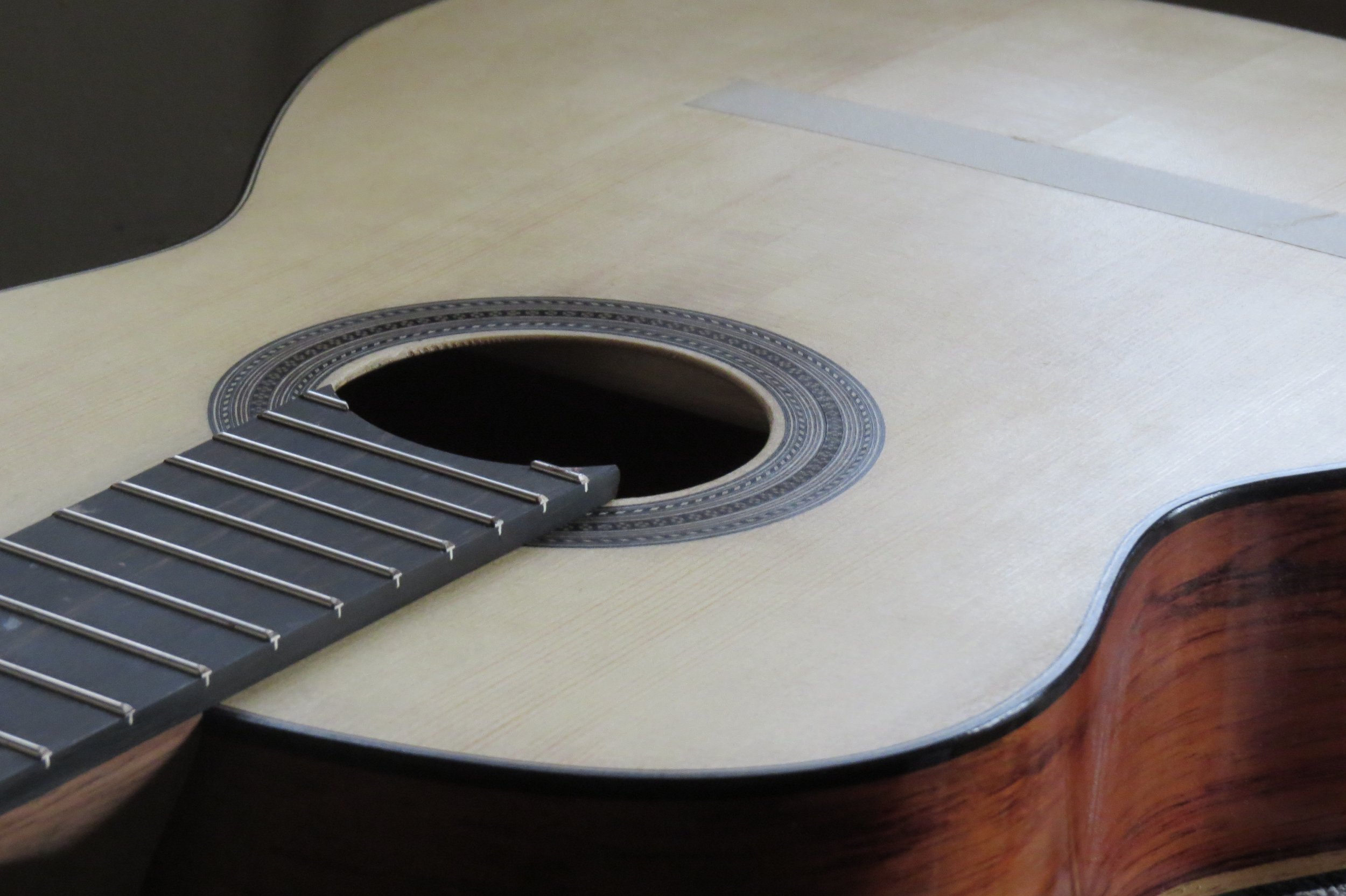Over the past year or so I’ve reached an exciting phase of my guitar making career. The tangible and visible elements of my guitars - such as the aesthetics, workmanship and the different types of polishing - are really coming together, and I’m close to finishing development on my own signature model. Some guitar makers develop their ideal guitar design, and once that’s done, they spend the rest of their career basically building the same guitar over and over, refining it over time. With many guitars you can take one look at the rosette, headstock shape, or even type of finish, and immediately know who built it. I really like this way of working as opposed to building copies of older guitar makers’ work. But best of all, now that I’m satisfied with the tangible considerations such as workmanship, finishing etc, that means even more energy can be put towards the sound, which is the most important thing after all.
In this post I’ll describe some of my recent work. While I was building these guitars, I was thinking ahead to the design of my signature model. The focus of my attention shifted very firmly towards the sound. I actually took the first of these guitars to a guitar making competition. For that competition guitar, I had a really strict zero tolerance policy towards any aspect of workmanship that I was the slightest bit unhappy about. I re-did any small mistake, and I have kept this practice, and therefore every guitar that leaves the workshop has gone through a vigorous quality control regime. I thought I was a perfectionist before, but the standard is definitely higher now.
Before building these guitars, thinking very much about how to achieve a stronger sounding guitar, I sought advice from some master guitar makers. I visited the now retired Paul Fischer in Oxford with a couple of guitars, as well as Rik Middleton in Coventry, and was able to show a guitar to German luthier Gernot Wagner in a chance meeting in London. So I’ve tried to incorporate some of the principles that they spoke about. I’m really glad to have the hurdle of workmanship out of the way, so I can focus very much on the sound. Crafting sound is something so interesting, mysterious and intangible. When speaking to the guitar makers I mentioned, I got a sense of this mysterious art being passed along. I feel like not many such arts still exist in the modern world, and if they do, they’ve been made partly redundant by modern technology. Happily, this isn’t the case with classical guitars. The guitars I’ll describe below were all made with wood given to me by Rik Middleton. It’s extremely beautiful, aged forever in his workshop, and I did my best to do it justice.
A flamenco guitar, made from spruce and flamed maple:
The design:
For the design of my flamenco guitars, I began by using a plan of a guitar by Santos Hernandez, a brilliant Spanish guitar maker of the 20th century. He used a variety of bracing patterns, but this one uses seven fan braces and no closing bars. Over the years I have continually refined the design, seeking what works best for me and the guitarists I get feedback from. I think the resulting sound is quite sweet, clean, and old-school. Even suitable for some classical players. Guitars of this general design were used when there was less of a distinction between flamenco and classical guitars, so guitars like this particularly tend to suit Spanish music of the early 20th century, as well as flamenco music. For the body shape I used my signature shape. The rosette is handmade by me, the mosaic inspired by a pattern used by Spanish builders such as Ramirez and Gerundino. The headstock shape was inspired by Paul Fischer; although I like it, I have an idea to develop it further, so I think the next guitar’s headstock will be even better.
The wood
Flamed Maple - Rik bought the flamed maple for this guitar early in his guitar making career, from a retiring cello maker; maple is also used for the back/sides of the violin family, but the varnish used is darker. Rik used maple from the same set to build his very first guitar, and had kept the rest his whole career. My first two guitars were built using maple too, one with plain maple, and the other with birdseye maple. So I’ve always been a maple fan. Maple is also one of the three woods regularly used by the maker Torres - he mostly used rosewood, cypress, and maple - therefore it has always been considered a very traditional wood for guitars. This is a beautiful set and was a delight to work with. Sometimes, very figured woods like this can be a pain to work with, however for such woods I use a tool called a toothing plane, and then a cabinet scraper, and usually avoid any problems.
Some snakewood bindings being sawn. A beautiful but difficult wood to work with
Snakewood - For the bindings and some decoration on the headstock I used snakewood. Snakewood is a beautiful wood which grows in some coastal areas in South America. It's not endangered but it’s quite difficult to get in lengths long enough to use for guitar binding. It’s generally a pain to use; it’s very dense and difficult to work; it splits easily making it difficult to bend. Due to these problems it’s only really used in small strips and not for anything structural. I discovered snakewood from looking into Paul Fischer’s work, who used it quite often for binding and decoration. I used three complimentary pieces of snakewood to make up the headstock veneer on this guitar. I also used double strips of snakewood for the binding. This is a touch of workmanship I’ve seen in the work of several high end luthiers, including Paul’s, Gernot Wagner’s, and David Rubio’s. It gives a stronger outline/border to the shape of the guitar.
Ebony - For the fretboard a very black ebony was used. Due to environmental concerns, it’s difficult to find ebony so black. It usually has some grey streaks amongst the black. I did some research last year into the sustainability of guitar woods, and ebony is definitely a wood I want to only buy from verified sustainable sources. The other difficult thing about ebony is that it seems to shrink continually, resulting in protruding fret ends and sometimes cracks alongside the fretboard. Rik had kept this piece of ebony for almost 25 years, and on it had written its weight over time. So it was interesting to see how much water it had lost over time.
Spruce - Spruce is the wood I’ve used most for the soundboards of my guitars. Soundboards are made with two bookmatched pieces of wood and joined in the middle. This particular example was already joined when I received it. But it had a dark stripe down the centre line, which occurs when the two pieces of the soundboard are very aged even before being joined and they begin to darken around the edges. Although this dark stripe is actually relatively common is guitars and not considered a flaw per se, I decided to unjoin the two pieces, get rid of the darkened section, and then rejoin them.
The golpeador
I’ve detailed how I glue a golpeador here: https://www.michaeledgeworthguitars.com/en/blog/how-i-glue-golpeadors-to-flamenco-guitars . The shape of this golpeador was inspired by the fact that many flamenco players like to rest the thumb of their right hand on the rosette, sometimes gouging into the finish and wood. This one extends over the rosette on that side. Thanks to my method of applying the golpeador, it’s fairly invisible to anyone looking at it from any distance.
The finish
For the back and sides I used a kind of lacquer, and for the soundboard and neck, French polish. Amongst many of the professional players I’ve spoken to, the overall consensus has been that they would prefer French polish for the soundboard, as it’s the thinnest finish and doesn’t impede the vibration of the soundboard, but that something that doesn’t wear so easily would be for more suitable for the back and sides. I don’t like to use lacquer for the neck as well, because then I feel the guitar tends to feel less like wood, and perhaps too ‘plasticky’, so for that reason I French polished the neck. There are a variety of different finishes, all difficult to master. I like using the most suitable finish for particular parts of the guitar, and it also gives me a chance to show off my finishing skills.
A classical guitar, made from spruce and a wood called Palo Escrito:
I will update this picture shortly once I’ve taken pictures of the completed instrument
The design
I have been developing my concert guitar for a while, and the design has gone through many changes. A little over a year ago, I showed luthier Paul Fischer a plan of the bracing pattern I was using at the time. We talked it through together and we made some changes. As I mentioned, around that time I was also in touch with other guitar makers, and the guitar design I have now was greatly influenced by my discussions with them. In my earlier guitars, I got to a point where I could consistently achieve a sweet sound with a good tone, but perhaps lacking in volume and projection. Therefore, I have been aiming for a more powerful guitar but without sacrificing the good qualities in my earlier guitars. The wood itself is quite beautiful on this guitar so I’ve kept the decoration fairly minimalistic, to let the beauty of the wood speak for itself.
The wood
Palo Escrito - Rik mentioned that Palo Escrito might be his favourite wood for its sound properties. It’s also visually stunning; a beautiful golden brown, it’s called ‘Escrito’ because it has grain lines that resemble writing. It’s a type of rosewood. To contrast against the Palo Escrito, I used ebony binding.
The finish
This guitar has, in theory, the perfect combination of finishes. I have long said that if I were to build a guitar for myself, I would like French polish for the top, lacquer for the back/sides, and oil for the neck. So, I finally carried out my idea on this guitar. I also French polished the headstock. I think this combination of finishes takes into account all sonic, visual and tactile concerns.
Many agree that oiled necks feel amazingly slick. For me, French polish is not only visually the most beautiful, but it’s also probably the best finish for the soundboard as it’s the thinnest. I’ve also spent many years refining my method for applying a particular kind of lacquer; it’s a very tough finish and easy to take care of, so perfect for the back and sides. Every guitar finish has strengths and weaknesses; I think I’ve used each finish in the best way here.
Some upcoming work:
In the coming months, I’ll be completing some exciting work. Two short-scale guitars; they will be very special instruments. One will be my first lattice instrument. Both with spruce soundboards, one will have Indian rosewood back/sides, and the other Pau Ferro. The most brilliant thing is that these soundboards were given to me by Rik, with the rosette and bracing already completed by him. So these guitars are a collaboration. And a chance for me to get a unique insight into his work and learn from his experience. I am ridiculously excited and I look forward to showing him and guitarists in general the finished instruments.
A soon to be completed short scale guitar with lattice, or ‘trellis’, bracing.
